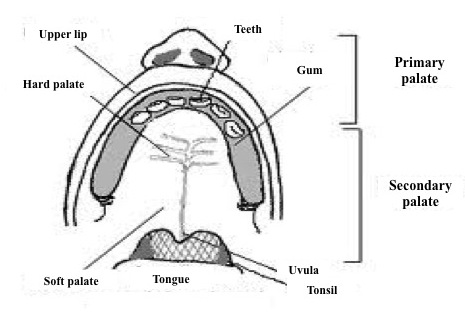The roof of the mouth in mammals that consists of the hard palate (anterior bony portion) and the soft palate (posterior muscular portion), which separates the oral and nasal cavities. The hard palate, encased in a mucous membrane, provides a surface against which the tongue can be moved and placed to enable sounds. Another function is to allow food to be chewed while breathing. The remaining third of the palate is the soft palate consisting of muscle fibers and connective tissue that terminates in the uvula. When it is lowered or retracted during breathing, it allows air to move in and out of the nose. During the utterance of most sounds it is raised or elevated, thus ensuring that the mouth alone forms the sound (e.g., a velar consonant when the middle of tongue touches the soft palate). When raised, it blocks off the nasal cavity and upper pharynx from the lower pharynx and mouth in order to allow food to be swallowed or to create a vacuum for drinking. If the soft palate is lowered, then nasal sounds are produced. Development of the palate begins during week 5 of gestation, starting with the primary palate, which carries the four incisor teeth. The secondary palate starts to develop by week 6. Together the primary and secondary palates to form to give rise to the hard and soft palates (see figure below). Failure of the hard and/or soft palate to fuse gives rise to the congenital malformation known as a cleft palate.
